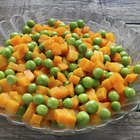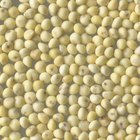
Salt adds flavor and enhances the flavor of other ingredients in a recipe. Too much salt, however, can overtake a dish -- and even make it inedible to some. When you've realized that you added too much salt to a recipe, find ways to cut the saltiness without throwing out the dish.
Potato
Fix stews and soups that are too salty by adding a potato. Wash, peel and roughly cut up the potato. Add the potato to the soup or stew while it’s simmering and allow the potatoes to absorb the salt. Remove the potato once it turns slightly translucent. Don’t serve the potato -- it’s likely to be too salty. The potato method only works on slightly oversalted soups and stews.
Sugar
Sugar helps cut through the taste of salt. Add a teaspoon of sugar at a time to an overly salty dish until the salt balances out. Add enough sugar to counteract the salt, but remember that you’re adding an additional flavor. Continue to taste the soup as you add, making sure that it doesn't become too sweet.
Fat
Fatty liquids and substances offer richness to a dish, and can cut through the taste of salt. When you have a dish that is too salty, add in a fat like butter, milk, buttermilk, sour cream or heavy cream. The fat doesn't absorb the salt. Instead, it coats your tongue, making you less sensitive to saltiness.
Water or Stock
Add additional water, stock or broth to an overly salty dish to dilute the liquid-to-salt ratio. Diluting might change the flavor profile of the entire dish, so have additional spices on hand to adjust the taste after the dilution is complete. When dilution isn’t an option, try removing half of the liquid in the dish and replacing it with fresh stock or water to decrease the amount of salt in the recipe.
Starches
Add a starch or grain to the dish to help absorb excess salt. Noodles or rice, for example, can soak up excess salt in a sauce, soup, stock or stew and then be strained out. When you add starch to your dish, your end result might be thicker than you intended. Fix this by adding additional liquid.
Acids
Acids cut through but don't absorb salt. Incorporate an acid that complements the original dish, such as lemon juice, lime juice, tomato, vinegar or wine.
Related Articles
How to Fix Pork Chops That Are Too Salty

How to Fix a Sweet Taste in Stews

How to Counteract the Bitter Taste of ...

How to Substitute Potato Starch for ...
How to Remove a Salty Taste From Sliced ...

How to Cut the Acidity of Vegetable Soup

How Can I Make Curry Taste Less Bitter?

How to Make Electrolyte Water With Salt ...

Can I Substitute Salt Pork for Smoked ...

How to Season Peas & Carrots

How to Thicken Sauce With Powdered ...
How to Use Potato Flakes to Thicken ...

How to Reduce Salty Taste in Soup

How to Make Salt Brine

How to Cook Millet Meal

Cooking Substitute for Tamarind ...

How to Cook Dried Black Beans in a Slow ...

How to Color Table Salt

How to Reduce the Vinegar Taste in ...

A Substitute for a Packaged, Dry, ...
References
Writer Bio
Shailynn Krow began writing professionally in 2002. She has contributed articles on food, weddings, travel, human resources/management and parenting to numerous online and offline publications. Krow holds a Bachelor of Science in psychology from the University of California, Los Angeles and an Associate of Science in pastry arts from the International Culinary Institute of America.
Photo Credits
Hemera Technologies/AbleStock.com/Getty Images